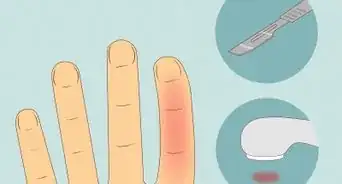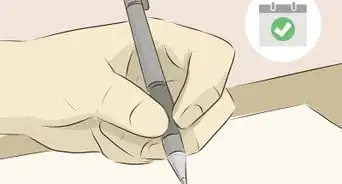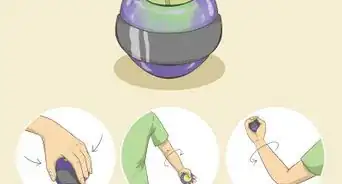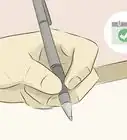This article was medically reviewed by Jonas DeMuro, MD. Dr. DeMuro is a board certified Pediatric Critical Care Surgeon in New York. He received his MD from Stony Brook University School of Medicine in 1996. He completed his fellowship in Surgical Critical Care at North Shore-Long Island Jewish Health System and was a previous American College of Surgeons (ACS) Fellow.
There are 8 references cited in this article, which can be found at the bottom of the page.
This article has been viewed 72,236 times.
Many active people or those who use their arms for work suffer from elbow injuries such as tennis elbow or tendinitis. If you or a loved one has pain and discomfort in your arm, you may be considering strapping your elbow to help it heal and relieve pain. There are different ways to strap your elbow including taping and bandaging. You may also need to take additional measures to help heal your elbow and alleviate any pain or discomfort you may have.
Steps
Preparing for the Elbow Strap
-
1Familiarize yourself with strapping options. There are different materials that you can buy to strap and support your elbow. Either trainer’s tape or kinesiology tape or tubular bandages can help limit your range of motion that is causing you discomfort, reduce stress on the injured tissue, and may allow more blood to flow to the injured area.
- Trainer’s and kinesiology tape are often best for muscle injuries. The tape expands when you move, making the treatment comfortable and practical if you have an active lifestyle or continue to exercise.
- If you have sensitive skin, consider trying quick release medical tape, which combines the strength of trainer’s and kinesiology tapes with less chance of irritating the skin during wear or removal.[1]
- Tubular medical bandages are wrapped around the affected area and then affixed with tape or a small fastener. This might also be a good option if you have sensitive skin.
- Tubular bandages are an especially good option for wrapping joints or even to cover tape.
- You can purchase trainer’s and kinesiology tape and bandages at many pharmacies, medical supply stores, and sports stores. Some larger retailers may also carry it.
- Consider trying to strap your elbow with duct tape, which is as supportive as trainer’s or kinesiology tape.
- Some professionals may recommend using black tape, as it can adhere better to sweaty skin.
-
2Buy bandages for your elbow. Purchase bandages to wrap, strap, and support your elbow. Bandages will support your elbow and they may also help to reduce any swelling you have.[2]
- You can use most types of medical wrap bandages at pharmacies, medical supply stores, and even some sports stores.
- Make sure to buy a bandage that is long enough to wrap your elbow enough to support and immobilize it.
- You will need to purchase medical tape or pins to keep the bandage in place.
Advertisement -
3Get your skin ready for taping or bandaging. Prepare your arm skin for taping or bandaging by washing and shaving it, if necessary. This can not only help remove dirt and debris, make the tape stick more effectively, but also may prevent any discomfort when you remove the tape or bandage.[3]
- Wash away any oils, sweat or dirt that may be on your skin with a gentle cleanser and warm water. This can minimize the risk that the tape or bandage doesn’t adhere properly to your arm.
- Any type of mild soap can effectively clean your arm. Make sure to rinse or wipe off all of the soap.
- If you have chosen not to use an underwrap (see next step) or have a lot of hair on your arm, you may want to shave your arm.
- Shave with care to prevent cutting your skin and causing injury.
-
4Protect your skin before taping or bandaging. If you prefer not to place the tape or bandage against your skin, place an underwrap between the tape and your skin. If you use an underwrap, be aware that it is not as effective as using tape only.[4]
- You do not have to use an underwrap or skin adhesives with tape or bandages.
- Spray the skin adhesive and or apply the underwrap to the areas of your arm you plan to wrap.
- You can buy underwrap and skin adhesive at most pharmacies, medical supply stores and some sports stores.
-
5Cut the tape for application. You may need to cut the tape before you wrap your elbow depending on whether you bought strips or a round of tape. Pre-cutting the tape can help ensure you use the right amount and prevent you from wasting any tape.
- Cut pieces of your tape to approximately the length of your forearm. You may also want some smaller pieces.
- Rounding the edges of the tape can make it easier to apply.
- If your tape has backing, remove it before application.
Applying Tape and Bandages
-
1Ask for help. You may find it difficult to wrap or tape your elbow with one arm. Consider asking a friend or family member to assist you taping and bandaging. This can help ensure proper application.
-
2Raise your arm for taping or bandaging. Hold up the arm you want to tape or bandage to one side. Keep your elbow straight and flex your wrist so your fingertips are pointing downwards.
- If you cannot hold up your arm, consider propping it up on a chair or the sofa to help you.
- Without stretching the tape, apply one piece down the length of your arm to just below your elbow.[5]
- Use the same principle with a bandage. Start at the wrist and bring the bandage up to just under the elbow.
-
3Continue to place the tape along your arm. You’ll need to wrap two more pieces of tape to strap your elbow. This will help ensure optimal support and stabilization.
- Make sure the tape is taut, but don’t wrap it tightly, which could cut off your circulation.
- If your skin gets irritated or throbs, you may have wrapped the tape or bandage so tightly that it cut off your circulation. Remove it immediately and reapply in a looser fashion.
-
4Wrap the tape or bandage around your forearm. Bring the tape or bandage around the front of your forearm in diagonal fashion in a downward motion. This can help provide extra support to your elbow and forearm areas.[6]
- Add one final piece of tape around the top of your wrist.
- Wrap the rest of the bandage around your arm. Overlap each layer slightly. The bandage should snugly and comfortably cover your elbow and forearm area.
- If you find that you need more support or still have pain, consider adding additional pieces of tape or even re-bandaging your arm more tightly.
-
5Secure the bandage. Once you have finished wrapping your elbow, secure the bandage so it doesn’t fall off. You can do this by attaching the end to the a safety pin, clip, or a piece of medical tape.
-
6Check the tightness of the bandage wrapping. Briefly walk around before starting any activity. If the tape or bandage is too tight, take it off and reapply or rewrap your elbow so that it is supportive, yet comfortable.[7]
- Check to make sure that the circulation is normal. Checking your pulse can help you figure out if the bandage is too tight. If your pulse is between 60 and 100, your circulation is fine and the bandage is not too tight. Finger swelling or a sensation of tightness could indicate that the dressing is too tight and needs to be loosened.
- You can also use the fingernail method. Press down on one of your fingernails and see how long it takes for the pink color to return to the nail. If it takes longer than four seconds, your blood circulation may be constricted, which could mean that the bandage is too tight.
Promoting Further Healing
-
1Give your elbow and arm a rest. Take some time rest or switch to lighter activities. Immobility, rest, and undertaking lower-impact activities may help heal your elbow and minimize pain.[8]
- Avoid high-impact sports such as running or tennis. Instead, try lower-impact options such as biking or walking.
- You may also want to allow your arms to rest completely for a few days or weeks.
- Start using the affected area more after you’ve rested. This can help minimize stiffness. If it causes too much pain, discontinue movement and see your doctor or get more rest.
-
2Apply ice to your elbow and arm. Place an ice pack or cold compress on your elbow and arm. This may reduce swelling and alleviate pain. Make sure there is a barrier between the ice and your skin — either the bandages or a towel to protect your skin from damage.[9]
- You can use an ice pack as often as necessary for 20 minutes at a time up to five times a day.
- You can freeze a styrofoam cup full of water to gently massage your elbow and arm with ice.
- If it is too cold or your skin gets numb, remove the pack.
-
3Take pain medication. Consider taking pain relievers for discomfort or severe pain. These medications can help relieve pain and may also reduce swelling.[10]
- Take over-the-counter pain relievers such as ibuprofen or naproxen sodium.
- Ibuprofen and naproxen sodium also have anti-inflammatory properties that can help decrease swelling.
-
4See your doctor. If taping, bandaging, and other treatments don’t relieve your elbow issues, consult your doctor. She may be able to figure out if you have a serious injury as well as help formulate an effective treatment plan.[11]
- You can see your regular doctor or visit an orthopedist, who specializes in treating disorders such as shin splints or tennis elbow.
- Your doctor will likely examine your arm and elbow to feel or look for signs of injury. She will also likely ask for a health history, such as what type of activities you do and what measures you’ve taken to reduce pain and promote healing.
- Your doctor may order additional tests such as an MRI or an X-ray to see your arm and elbow in greater detail. This can help her make a definitive diagnosis.
Warnings
- Some people are allergic to the different types of medical or training tape available. You should test the tape on your skin before using it.⧼thumbs_response⧽
References
- ↑ http://www.ncbi.nlm.nih.gov/pmc/articles/PMC3503228/
- ↑ https://www.footcaremd.org/resources/how-to-help/how-to-tape-an-ankle
- ↑ https://www.marshfieldclinic.org/mHealthyLiving/Documents/Athletic-Taping-An-Ankle.pdf
- ↑ https://www.footcaremd.org/resources/how-to-help/how-to-tape-an-ankle
- ↑ https://www.heighpubs.org/jnpr/jnpr-aid1025.php
- ↑ https://www.heighpubs.org/jnpr/jnpr-aid1025.php
- ↑ https://www.marshfieldclinic.org/mHealthyLiving/Documents/Athletic-Taping-An-Ankle.pdf
- ↑ https://www.nhs.uk/conditions/tennis-elbow/treatment/
- ↑ https://www.healthdirect.gov.au/tennis-elbow#treated-prevented














-Step-15-Version-3.webp)





















-Step-15-Version-3.webp)



































Medical Disclaimer
The content of this article is not intended to be a substitute for professional medical advice, examination, diagnosis, or treatment. You should always contact your doctor or other qualified healthcare professional before starting, changing, or stopping any kind of health treatment.
Read More...